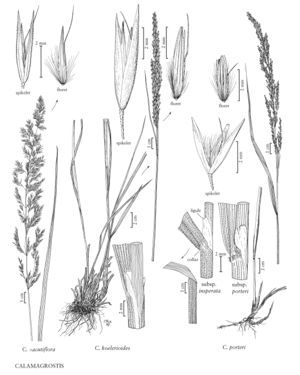Difference between revisions of "Calamagrostis koelerioides"
FNA>Volume Importer |
FNA>Volume Importer |
||
| Line 17: | Line 17: | ||
-->{{Treatment/Body | -->{{Treatment/Body | ||
|distribution=Wash.;Calif.;Oreg.;Mont.;Idaho;Wyo. | |distribution=Wash.;Calif.;Oreg.;Mont.;Idaho;Wyo. | ||
| − | |discussion=<p>Calamagrostis koelerioides grows in mountain meadows, chaparral, and Jeffrey pine and blue spruce forests, and on talus slopes, dry hills, and ridges, occasionally on serpentine soils, at 50-2100 m. It extends from Washington south to southern California and east to Montana and western Wyoming.</p><!-- | + | |discussion=<p><i>Calamagrostis koelerioides</i> grows in mountain meadows, chaparral, and Jeffrey pine and blue spruce forests, and on talus slopes, dry hills, and ridges, occasionally on serpentine soils, at 50-2100 m. It extends from Washington south to southern California and east to Montana and western Wyoming.</p><!-- |
| − | --><p>Calamagrostis koelerioides is similar to C. rubescens (p. 723). The two have traditionally been distinguished by the presence of hairs on the leaf collars in C. rubescens, and their absence in C. koelerioides; a more reliable differentiation is the longer lemmas, glumes, and awns of C. koelerioides compared to C. rubescens.</p> | + | --><p><i>Calamagrostis koelerioides</i> is similar to <i>C. rubescens</i> (p. 723). The two have traditionally been distinguished by the presence of hairs on the leaf collars in <i>C. rubescens</i>, and their absence in <i>C. koelerioides</i>; a more reliable differentiation is the longer lemmas, glumes, and awns of <i>C. koelerioides</i> compared to <i>C. rubescens</i>.</p> |
|tables= | |tables= | ||
|references= | |references= | ||
| Line 27: | Line 27: | ||
-->{{#Taxon: | -->{{#Taxon: | ||
name=Calamagrostis koelerioides | name=Calamagrostis koelerioides | ||
| − | |||
|authority=Vasey | |authority=Vasey | ||
|rank=species | |rank=species | ||
| Line 34: | Line 33: | ||
|basionyms= | |basionyms= | ||
|family=Poaceae | |family=Poaceae | ||
| − | |illustrator=Cindy Roché | + | |illustrator=Cindy Roché;Hana Pazdírková |
| + | |illustration copyright=Utah State University | ||
|distribution=Wash.;Calif.;Oreg.;Mont.;Idaho;Wyo. | |distribution=Wash.;Calif.;Oreg.;Mont.;Idaho;Wyo. | ||
|reference=None | |reference=None | ||
| Line 40: | Line 40: | ||
|publication year= | |publication year= | ||
|special status= | |special status= | ||
| − | |source xml=https:// | + | |source xml=https://jpend@bitbucket.org/aafc-mbb/fna-data-curation.git/src/f50eec43f223ca0e34566be0b046453a0960e173/coarse_grained_fna_xml/V24/V24_1018.xml |
|subfamily=Poaceae subfam. Pooideae | |subfamily=Poaceae subfam. Pooideae | ||
|tribe=Poaceae tribe Poeae | |tribe=Poaceae tribe Poeae | ||
Revision as of 20:17, 16 December 2019
Plants without sterile culms; often densely cespitose, with rhizomes 2-6 cm long, 2-4 mm thick. Culms (26)60-85(120) cm, unbranched, slightly scabrous; nodes 2-3(5). Sheaths and collars usually scabrous, rarely smooth, glabrous; ligules (1.5) 2-4.5(7) mm, truncate to obtuse, entire or sometimes lacerate; blades (2)9-20(30) cm long, (2)2.5-4.5(8) mm wide, flat, slightly scabrous, adaxial surfaces glabrous or sparsely hairy. Panicles (4)10-13(16) cm long, about 1 cm wide, contracted, erect to slightly nodding, often slightly interrupted towards the base, straw-colored or pale green to pale purple; branches (1.1)2.8-4(6) cm, scabrous, spikelet-bearing to the base. Spikelets (4)4.5-6(7) mm; rachilla prolongations 1.5-2.5(3) mm, hairs 1.5-2 mm. Glumes slightly keeled, keels smooth or slightly scabrous distally, lateral veins visible but not prominent, apices acute; callus hairs 1.5-2 mm, 0.3-0.4 times as long as the lemmas, sparse; lemmas (3.5)4-5(6) mm, 0.5-1.5 mm shorter than the glumes; awns 4-5.5 mm, attached to the lower 1/10 – 1/5 of the lemmas, exserted, sometimes barely so, stout, distinguishable from the callus hairs, bent; anthers 2-3.5 mm. 2n = 28.
Distribution
Wash., Calif., Oreg., Mont., Idaho, Wyo.
Discussion
Calamagrostis koelerioides grows in mountain meadows, chaparral, and Jeffrey pine and blue spruce forests, and on talus slopes, dry hills, and ridges, occasionally on serpentine soils, at 50-2100 m. It extends from Washington south to southern California and east to Montana and western Wyoming.
Calamagrostis koelerioides is similar to C. rubescens (p. 723). The two have traditionally been distinguished by the presence of hairs on the leaf collars in C. rubescens, and their absence in C. koelerioides; a more reliable differentiation is the longer lemmas, glumes, and awns of C. koelerioides compared to C. rubescens.
Selected References
None.
